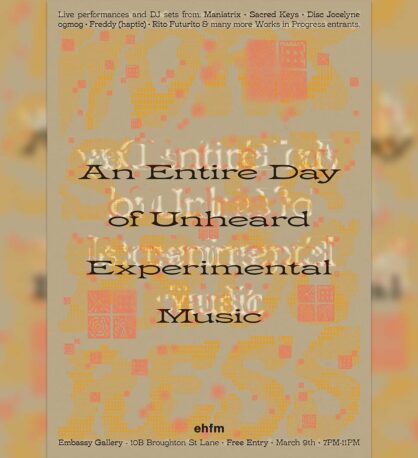joy and nostalgia are the same rose tinted thing
joy and nostalgia are the same rose tinted thing
Megan Rudden’s video and text commission was initially planned as part of Sweet 16, a proposed programme in 2019/20 that aimed to celebrate the histories and ongoing work of EMBASSY gallery by centring on its archive. Now, a year on, we are delighted to present a new work by the artist, joy and nostalgia are the same rose tinted thing (2021).
In early March 2020 the artist spent one day exploring EMBASSY’s archive: just before lockdown, when EMBASSY’s activities began to wane, and the project momentarily came to a halt. To reflect upon this commission is to search for many different ends and beginnings, and to look to the times between them: the pauses.
EMBASSY gallery’s archive is made up of sixteen years of posters, accounts, receipts, technical instructions, cashed cheques, artist correspondence, minutes, stickers, tapes, an invigilation jacket, and objects or ephemera that evade categorisation. What these materials and artefacts attest to are the undocumented labours and memories of those involved with EMBASSY: a testament to the ‘back-end’ workings that roll and transform quietly. Megan then concentrated her interest on the undocumented labours and memories of an organisation such as EMBASSY, which are attested to through such materials and artefacts. joy and nostalgia are the same rose tinted thing is a love-letter to the artist-led, to support structures, expectations, and obligations. It recalls a shapeshifting entity.
Through film and text, Megan considers what the archive was and what it is subjectively. We might consider it an entity stuck in limbo, that does not exist upon stable ground. ‘How can we talk about archive when the one I have is sick?’, asks the artist. It is fragmented, contingent, and incomplete: made up of loose conversations and mythologised inheritances. To focus on embodied knowledge of organisations can be to look with affection.
What the archive project could once have been doesn’t matter now.
“what this was going to be and what it is now.”
How do you write about the ‘social debris’* of an archive when both of those parts aren’t available?
***
* “It matters that something was yellow, not red, that it passed in a blur, or something moaned. A bit of social debris, a scattering of material-aesthetic forms taken up or left to languish like litter are an archive of objects of attention. Regleaning them is a thought prac-tice that needs materials to think with more than it needs the attitude-skill of debunking.”
– Lauren Gail Berlant and Kathleen Stewart, The Hundreds (Durham: Duke University Press, 2019) p. 15
Full transcript is available here
Megan Rudden



